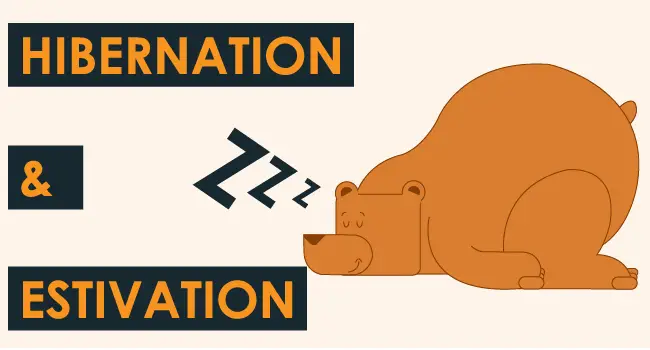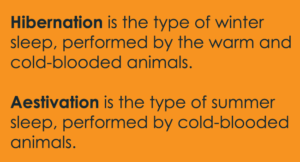
Difference Between Hibernation and Estivation / Aestivation (with video)
Hibernation vs Estivation , both are two different terminologies. Hibernation in simple words also known as winter sleep that animals usually take in the winter season for a long. Estivation or aestivation is the sleep that animals take in summer and is not usually long as hibernation.
In simple words; aestivation is hibernation in summer.
also check: Simple and compound leaves differences
Both are sleep categories and both possess importance as they are a way to conserve the energy of an organism’s body. During both, sleep the energy consumption levels of the organism reduced around 90 times lesser than the consumption usually.
When any animal aestivates or hibernates, its body’s metabolic activity goes down which results in laziness, and this laziness results in an ultimate sleep. Also when any animal goes onto the state of being hibernated or aestivated before this they acquire a lot of food to retain in the body to get nutrients extracted from them during the nap period.
In spite of the fact sometimes the organism wakes up from sleep, may be at regular intervals to take outside air and profound inhale, however when the season change, the excitement begins with the interior body framework begins getting dynamic gradually. It takes very little time for animals to get totally dynamic/active.
With the method of featuring the significance of two sleep types, we will also study how these two sleep categories differ from each other.
Estivation vs hibernation

| HIBERNATION | ESTIVATION / AESTIVATION |
| Hibernation is the sleep type that is acquired by cold or warm-blooded organisms in the winter timeframe. | Estivation is the sleep type that is acquired by solely cold-blooded animals in the summer time frame. |
| The dormant winter sleep in which organisms metabolic activity go down and they prefer warmer places to stay. | In this, they look for cool, shady, and moist spots and it is not as dormant as hibernation. Overall the metabolic activities near to same as in animals during hibernation. |
| It may continue for the whole winter season. | It is not for the whole season and there are many short intervals within the complete aestivation process. |
| It aids in maintaining the internal body temperature and shielding the internal body conditions. | It aids in maintaining the internal body temperature and shielding the internal body conditions by retaining the water content inside as the more water wastage happens during high-level activities during awake. |
| Woodchunks, turtles, snakes, bats, bees, ground squirrel, hedgehogs are the animals instances that hibernate. | Snail, lion, salamanders, desert tortoise, cats, and cane toads are the best examples of estivation animals. |
also read: sleep and hibernation difference
let’s look at each hibernation and estivation in detail
What is Hibernation?
The term hibernation qualifies as a state or condition of nap or dormancy noted in endotherms. It is usually known with the name as deep winter sleep as animals acquire it in the winter time frame. it is characterized by slow heart rate and breathes which ultimately results in a low metabolic activity rate.
Animals that fits best in the hibernating animal category are fishes, birds, insects, and many mammals. Moreover, rodents are categorized as the best hibernators as they hibernate extremely deep.
There are many mammals that are not very true hibernate as their body temperature does not go much down as other true hibernating animals. Also, such mammals are not really purely inactive as other hibernating animals.
Insects hibernate in such a way that they keep themselves warm in ground holes, or in rotting logs, or beneath tree bark, on the other hand, fishes and turtles keep themselves shelter in deep lake water by burrowing mud surface.
Hibernations is also known as the siesta condition as the organism arise to be practically dead or very much close to it. The temperature is near t zero degrees Celcius and the only crucial framework which is dynamic in their body is breathing which is solely to supply the oxygenated blood to the whole body., which is additionally at a more slow rate, similar to their pulse.
Another fundamental issue faced by such organisms is not enough food supply. Consequently, before winter rest the organisms eat excess food and store it as overabundance fat, which is provided as energy supply while dozing.
While organisms hibernate mix at very few stretches to deal with themselves again & re-appearance of a comparative express, this is where they are introduced to the sparkle, and step by step get dynamic for a long time.
Why Do Animals Hibernate?
They do hibernate in the winter season because of not enough food available out there. They store enough food in their bodies before they go for hibernation in warm places to utilize it during the hibernating period.
If we go more in detail then there are many things to know related to their internal body conditions when they hibernate. Following are their body conditions when they hibernate:
- Their body temperature goes down even to zero degrees sometimes.
- Very slow metabolism because in this way there is no instant food digestion which ultimately result in retained calories inside the body.
- They don’t pee and poop.
- Very low but managed oxygen supply to the whole body organs through blood circulation.
Hibernation examples:
- Bears are the best example of a hibernating organism as they go for it in their dens. Usually, they start their hibernating period around the month of September or October and they come out after 6/7 months around April month.
- We usually don’t see bees, frogs, and wasps in winter because they are hibernating.
What animals hibernate in the summer or estivate?
There are many organisms that do estivate in the summer season, but some common are these; Snail, ladybird, secretive salamander, speedy mouse, hedgehog, fragile frog, lungfish, tortoise.
What is Estivation?
Estivation/aestivation definition is practically indistinguishable from hibernation, yet the particular basic deviation is that aestivation is the to rest inactive during summer and is short than hibernation.
It is considered by the animals nourishing/residing in tropical or desert areas.
It happens as a result of the hot and dry atmosphere just as because of the absence of food and water in hibernation.
As the summer begins, lakes start getting dry, accordingly the situation, fishes get themselves buried into mud depths. In this situation fishes release mucus in a large quantity which helps them cover their whole body, the mucus they secrets work the same as the moisture pouch around them which shelters and keep them moist during the course of the whole summer season. During this, the fish inhales through the mucous looms.
Why Do Animals Estivate?
Animals estivate and the centric purpose of this phenomenon for animals is to save calories during this harsh season as there is a lot of water consumption during summer.
The essential physiological and biochemical concerns for an organism to estivate are to retain energy, hold water in the overall body, proportion the utilization of put away energy, handle the nitrogenous finished results, and settle substantial organs, cells, and macromolecules.
Estivation examples:
- Lions after hunting and having a heavy meal sleep beneath shady trees, they are actually estivating, because, for them, there are very low preying opportunities during the summer.
- African lungfish.
- Tortoise.
- Salamanders.
- red-legged frogs.
What is Brumation?
Brumation is a lethargic period for reptiles. Similarly, as with hibernation in warm-blooded animals, their bodies shut down and preserve the energy for the year coming ahead. In the brumation timeframe, a reptile may not defecate, drink, eat, for certain weeks. It might cover itself entirely underground or go to the haziest, coolest spot of its nook.
It can terrify you when your pet doesn’t react to ordinary improvements, for example, jabbing and pushing.
females and males can go into this sort of sleep, with males generally arising out of their profound rest before the females. They may likewise brumate anytime through the year, so this is certifiably not occasional conduct like the pure hibernation.
What is Torpor?
Similar to hibernation, torpor is a survivance strategy considered by organisms to get survivorship in the cold weather months. It likewise includes a lower internal heat level, pulse, and metabolic rate, breathing rate.
In contrast to hibernation, it seems to be a reflexive condition an organism goes into as the conditions direct. Additionally, it continues for a short interval usually just a day or night contingent upon the organism’s meal patterns. we in simple words can say it as a light category of hibernation.
Animals within their dynamic day frame, manage normal physiological and body temperatures rates. However, while they are dormant, they go into a more profound rest that permits them to preserve energy and make survivance during the colder wintertime.
usually, animals take around 50 minutes for complete arousal from a torpor state and within these minutes they shake their whole body to activate and stretch their muscles.
What is Diapause?
Diapause can be characterized as the physiological lethargy condition or formative arrest where most life measures are closed down. It is begun during troublesome conditions out and is most generally seen specifically in insects and arthropods.
It can happen at any stage during the insect’s life cycle – from its stage of pupae to the dynamic adultery stage. At the point when this marvel happens during the egg/pupil stage, the advancement eases back down to a stop. In the grown-up/adultery stage, regenerative conduct or feeding habits are ended or eased back down.
before you go have a look at some major hibernation and estivation differences.
What is the difference between Estivation and Hibernation
Hibernation is considered by animals for the whole winter season in which they et enough rest in warmth and lower their metabolism at the extreme. While estivation is alternate to it but not so much as it is for a short period of time and happens in the summer season with intervals. But the metabolic framework is almost the same as hibernation.
Hibernation is considered by warm-blooded organisms in the ecosystem. While estivation is considered by cold-blooded organisms.
In estivation animals prefer for cool, moisty, and shady places. On the other hand in hibernation, they prefer for warm places.
Animals go for hibernation due to the fact there is not enough food supply in winter. While in estivation they go for it to retain the water content and calories inside.
What is the the summer equivalent of hibernation called?
Estivation/Aestivation in summer is correspondent to hibernation which typically animals utilize to conserve vitality in winter or extreme cold season. It can also be stated as animals that hibernate in summer is known as aestivation.
What is estivation how is it similar to hibernation?
Borth states are taken into consideration by animals in opposite extreme weather conditions, both are long sleep kinds for energy conservation with minimal metabolic activities.
Conclusion (hibernation and estivation)
We have gone through hibernation and estivation. Both in simple words are specific sleep categories that different animals utilize or get benefit from. Ultimately both have a serious relationship to the ecosystem and environment as described above. Also, we have studied why animals experience these processes hibernation and estivation.
You may also enjoy reading: